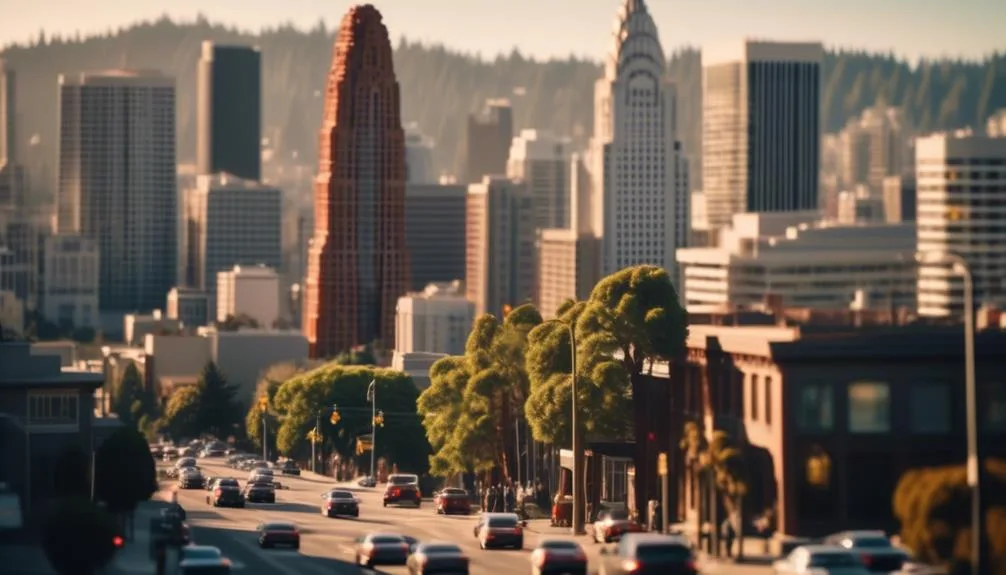Can redwood trees thrive in cities?
Picture a redwood tree in the middle of a bustling city, standing strong amidst the buildings. Recent studies challenge the idea that this is impossible.
Understanding how these trees could survive in urban areas and the potential solutions is crucial.
Exploring the relationship between nature and city life could change our view of sustainable living in urban environments.
Urban Environment Challenges
In urban environments, Redwood trees face numerous challenges. Limited space and competition for resources are among these challenges. In dense forests, the expansive tree canopy provides protection for Redwoods. However, in urban areas, the tree canopy is often reduced, exposing the Redwoods to increased levels of air pollution. This exposure can have detrimental effects on their health and growth. Another challenge is the limited space in urban settings. Redwood trees must compete with other vegetation for essential resources like water and sunlight. Additionally, human disturbances, such as construction and foot traffic, further add to the challenges faced by Redwoods in urban areas. Despite these obstacles, efforts to mitigate air pollution and protect urban green spaces can greatly benefit the resilience of these majestic trees.
Redwood Tree Adaptability
Despite the challenges of urban environments, Redwood trees demonstrate remarkable adaptability in their ability to thrive amidst limited space and competition for resources. These trees have evolved to cope with urban settings, showcasing resilience in the face of environmental stressors. Their adaptability is evident in various aspects, including tree growth and environmental impact.
| Tree Growth | Environmental Impact |
|---|---|
| Redwoods adjust their root systems to grow in confined spaces, allowing them to thrive in urban settings where space is limited. | Redwood trees play a crucial role in reducing air pollution and mitigating the urban heat island effect. Their large canopies provide shade and absorb carbon dioxide, contributing to improved air quality. |
| Redwoods have the ability to grow rapidly, allowing them to compete for sunlight and nutrients in densely populated urban areas. | Their extensive root systems help prevent soil erosion and improve water retention, benefiting the overall urban ecosystem. |
Redwood trees' adaptability not only facilitates their survival but also enhances the urban environment.
Soil and Water Considerations
Redwood trees' remarkable adaptability extends to their interaction with soil and water in urban settings, where their root systems and water retention qualities play a crucial role in maintaining the urban ecosystem.
- Soil Composition: Redwoods can thrive in a variety of soil types, but they prefer well-drained, slightly acidic soils. Their shallow, wide-spreading roots are well-suited for urban environments, as they can adapt to compacted soils commonly found in cities.
- Water Availability: Redwoods have a remarkable ability to retain water, which is beneficial in urban environments where water availability may fluctuate. Their thick, moisture-retaining bark and extensive root systems help them survive dry periods, making them an asset in maintaining the balance of urban water cycles.
- Urban Ecosystem: By effectively managing soil moisture and adapting to different soil compositions, redwood trees contribute to the overall health and sustainability of urban ecosystems.
Urban Planning and Maintenance
Sustainable growth of redwood trees in urban settings requires thoughtful urban planning and maintenance. Urban planners can incorporate green spaces and parks with suitable conditions for redwood trees to thrive.
Furthermore, maintenance strategies such as regular watering, mulching, and pruning can contribute to the overall health of the trees. Community engagement is also crucial in urban settings, as it can foster a sense of ownership and responsibility for the care of redwood trees.
Successful Urban Redwood Tree Examples
Thriving in bustling city centers and quiet suburban neighborhoods alike, urban redwood trees stand as majestic examples of nature's resilience and beauty. These towering giants not only provide a stunning addition to urban landscapes but also offer numerous benefits to the communities they inhabit.
- Tree Canopy: Urban redwoods, such as those in San Francisco's Golden Gate Park, create an expansive and cooling tree canopy, offering shade and reducing the urban heat island effect.
- Community Engagement: Redwood trees in urban settings often become focal points for community engagement. For example, the Redwood Memorial Grove in Oakland serves as a gathering place for events and activities, fostering a sense of unity and pride among residents.
- Environmental Impact: Cities like Portland have successfully integrated redwood trees into their urban planning, showcasing how these trees contribute to improved air quality and overall ecosystem health.
Conclusion
Ultimately, redwood trees can thrive in urban settings with proper planning and care, showcasing adaptability to city environments. Their ability to flourish in challenging conditions offers inspiration for integrating these majestic giants into urban landscapes.
How can the presence of urban redwood trees enhance the well-being of city inhabitants?
Mark Hoffman is a dedicated arborist and tree care specialist with over a decade of experience. His love for trees began when he visited Yosemite National Park as a teenager and was awestruck by the giant sequoias. Mark pursued his passion by studying forestry at Michigan Technological University, where he earned a Bachelor of Science degree.
Since then, he has worked tirelessly in the field of arboriculture, helping to preserve and protect trees in his community. His expertise and dedication have made him a respected leader in the industry and a valuable resource for anyone seeking advice on tree care.
